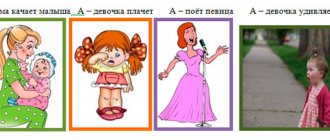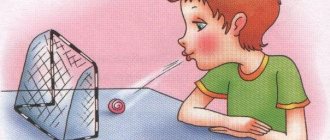Among other types, auditory memory occupies a special place, because from the very birth a child is surrounded by a variety of sounds. He receives the first information about the world around him through hearing, so good auditory perception gives children a correct understanding of objects and phenomena. However, although parents know about this, sometimes they do not pay attention to the problems with auditory memory that appear in their children. The main one is that children seem to listen, but do not hear the adult’s words (instructions, directions, explanations). Often preschoolers cannot concentrate on sound material, for example, when doing tasks in kindergarten, and schoolchildren cannot concentrate on writing dictations, reading educational texts, or solving oral problems. Sometimes they have difficulty remembering and reproducing information they have heard. All this creates certain difficulties in preschool development and school education. In order to eliminate such deficiencies in a timely manner, parents need to take seriously the development of auditory memory in their children at home.
How to properly develop auditory memory in children?
Despite the fact that in home studies, parents can use simpler and more accessible exercises for the development of auditory attention and memory, in contrast to developmental classes with specialists, they must certainly take into account the characteristics of the auditory development of children at different age stages. What do parents pay attention to when organizing activities at home?
- During its formation, auditory memory is based on the development of auditory attention. Therefore, it is necessary to organize classes with the child in the form of complex training, when both auditory memory and auditory attention are simultaneously exercised.
- The first thing you need to pay attention to is how developed phonemic awareness is in children, that is, the ability to distinguish and recognize words. If a child does not distinguish phonemes (word units), this prevents him from mastering vocabulary and inhibits the development of speech and auditory memory.
- It is also necessary to take into account that the development of hearing at different age stages has its own specific characteristics. For example, in the first year of life, auditory attention is actively developing. During this period, the child listens to the source of the sound, reacts to it with body movements, recognizes the voices of relatives and strangers, and responds emotionally to different intonations of the voice. If adults help the baby develop such reactions, then already in the second half of the year he learns to imitate the sounds he hears, tries to reproduce them with a certain intonation and rhythm. At an early age (2-3 years), the baby repeats the sounds he hears in words and actively uses them. Parents need to know all this in order to choose the right games and exercises for the development of auditory memory and attention. Middle and older preschoolers hear and then repeat sound rhythms according to a model or according to oral instructions.
- Experts note that in early childhood there is a close relationship between auditory and visual memory. They explain this by saying that to better assimilate information, the child uses not only hearing, but also vision. For example, memorizing words denoting any objects will go faster if the baby can see them. In the same way, auditory perception of the names of objects is easier when a preschooler's motor skills are involved. The adult names the object and gives the child the opportunity to act with it: roll, throw, play.
- To develop auditory memory in children, it is necessary to use a variety of means. Many techniques have been developed in the methodology, but the most important continues to be play, as the leading activity of preschoolers. And gaming techniques also help younger schoolchildren master many knowledge, skills, and abilities.
Why do you need to conduct game training?
The process of child speech development largely depends on the development of phonemic hearing. Phonemic hearing is the ability to separate some speech sounds from others. Auditory memory training allows the baby to distinguish words that sound similar, such as mal-myal, rak-lak, tom-dom and others.
Poor development in a child
Insufficient development of auditory memory is the reason for the incorrect pronunciation of certain sounds, words and phrase combinations subsequently. Even in adulthood, a person will confuse or pronounce sounds incorrectly if in childhood he was not given appropriate lessons on training the type of memory in question. As a rule, such classes are organized by a speech therapist, but in some (not neglected) cases, parents cope themselves at home, having conversations with children in a playful way.
What do we have to do?
If you notice that the child does not clearly and correctly pronounce any sounds or does not pronounce whole words clearly enough, you should not let the problem take its course. Don't think that the problem will go away on its own with age. Pay attention to the baby's speech. The sooner you take action, the easier and more quickly the issue will be resolved. By following the above instructions and having conversations with your child in the form of a game, you will improve your baby’s auditory memory and teach him to be more attentive, which will definitely come in handy in adulthood.
Exciting games and exercises for developing auditory memory and attention
Experts have developed many games and exercises that will help parents organize home activities with their children to develop auditory attention and auditory memory.
Classic games have proven themselves in educational activities, but you can diversify them with various variations. Much depends on the creativity, interest of parents, age and psychological characteristics of the kids.
What games and exercises do kids need?
Adults should actively involve young children in games for auditory perception and subsequent reproduction of the information received. Taking into account the age characteristics of children, it is necessary to organize support for their motor skills and visual perception. Therefore, all games and exercises must be carried out in a comprehensive manner, solving problems of auditory, visual, and motor memory. In order to interest children, you can use nursery rhymes, rhymes, and songs. After the lesson, it is necessary to encourage the child and encourage him to play independently.
"Guess what's playing?"
The game actively develops auditory memory and attention by relying on visual images. An adult examines musical toys together with a child. For this fun, you can take all the toys you can find in the house: drum, bell, xylophone, pipe, tambourine, tumbler, rattle. It’s good if all game actions are accompanied by funny rhymes and nursery rhymes:
The most fun toy of all is the Painted Rattle Tink, tinkle...
Tram-there-there, tram-there-there, Drum the drum. It's very loud, I know it myself...
How the bear went to dance, sing and hit the tambourine: Boom! Boom! Tram - ta - ry! Fly away, mosquitoes!
Ding-dong - xylophone, A gentle chime is heard. I hit the blocks, ding-dong, I create ringing melodies...
"Musical Echo"
An exercise to develop auditory memory for preschool children, develops the ability to understand and repeat rhythm. It can be used for children of different preschool ages; the difference will only be in the complexity of the rhythmic actions. The adult taps out a very simple rhythm for younger preschoolers, for example, two short beats, one long; for older preschoolers, you can offer the rhythm of a melody. The child must listen carefully and repeat. To maintain interest, it is good to offer two or more children a competition to see who can complete the task faster and more correctly.
“Draw what you heard?”
The exercise is aimed at developing auditory attention and perception, the ability to remember, and reproduce what is heard. The complex develops motor sensations. The adult invites the preschooler to listen to the poetic lines, remember all the images and sketch them from memory. For kids, all objects depicted in poems should be familiar and easy to depict. You can maintain interest in the task if you hang your child’s drawings on the wall or create an album with him.
Poem by A. Akhundova:
Hot air balloon, hot air balloon Breaks out of your hands. Naughty, naughty - Suddenly flies up to the ceiling. I need to catch him and tie him by the tail.
Or a poem by S. Marshak:
My cheerful, ringing ball Where did you start galloping, Yellow, red, blue, I can’t keep up with you.
"Mouse"
Fun helps develop auditory perception, attention, and teaches you to recognize by ear the tempo, timbre, and rhythm of sounds. The adult invites the child to become a “mouse” that walks around the room to a certain rhythm. When the tambourine sounds quietly and slowly, the mouse goes out for a walk; as soon as the tambourine sounds loud and fast, the mouse hides, because the cat is approaching. In this fun, an adult can show creativity and invite the child to play with different scenes: sun - rain, fungus - boy with a basket, butterfly - net.
“One word, two words - there will be a song”
This game is a lot of fun for children, but it requires that children have at least a little experience. You can offer it to kids and make it more complicated as the child learns children's songs. Middle school children can easily take part in this fun. The adult makes a selection of familiar songs and lets the child listen to them. He must guess what song was played. To maintain interest, the parent sings a familiar verse with the baby. For middle and older preschoolers, it will be interesting to introduce a competitive element into the game; whoever guesses the most melodies wins a prize. The fun is also good for family leisure. On a walk or in the country, you can play this game with voice accompaniment.
Games and exercises for middle and older preschoolers
In middle and older preschool age, auditory memory exercises become more complex, as the tasks of working with children become more complex. For example, much attention is paid to the formation of their phonemic hearing, the good development of which is necessary when learning to read and write. An older preschooler should be able not only to perceive sounds, but also to distinguish them according to their sound composition, according to individual characteristics (hardness - softness, sonority - deafness). Children need to learn to voluntarily concentrate on the perceived text and understand the task by ear. Parents are required to create a home environment that is aimed at developing auditory perception, attention and memory. These are not only special games and exercises, but also the whole way of life of the family.
- The speech and listening of an adult should be an example for the child to follow: parents themselves must observe the intonation expressiveness of speech, teach the ability to listen to each other, not shout when communicating, draw children’s attention to the beauty of natural sounds, distinguishing them by pitch, timbre, and rhythm.
- Eliminating irritating noise in the house, which distracts children's attention, leads to hearing strain.
- Organize a variety of leisure activities for preschool children, visiting with them musical theater, children's theater performances with musical accompaniment, and playing games in the family circle - dramatizations based on folk tales, nursery rhymes, and rhymes.
- Create a developing subject environment by offering children educational (didactic) games, listening to audio cassettes with songs and fairy tales, and replenishing the play corner with musical toys: flute, children's piano, harmonica.
- If possible, offer your child to attend a music or choir club.
What games and exercises can parents do with middle and older preschoolers to develop auditory attention? Experts offer both classic and modern games for training to develop auditory memory and attention.
“What cars are in the garage?”
The game develops auditory perception, teaches to distinguish sounds by timbre and pitch, and helps several children spend their leisure time in an interesting way. An adult invites the children to build a garage that can accommodate all the cars in the play area. The presenter negotiates with the players what sound signals the cars will use in different compartments. Compartments can be distinguished by color, for example, in red – cars with a high sound (small “bi-bi” cars), in blue – with a loud and low sound (professional cars: fire truck, truck). Each child must remember his signal and try to reproduce it. The plots of the game can be different: “all the cars go about their business”, “they let a fire truck pass”, “trucks are carrying cargo to a construction site”, “buses are taking children on an excursion”.
“Remember the color and color it”
Didactic game for the development of auditory perception, correlating the visual image with the auditory one. The adult invites the preschooler to listen carefully to the poem and remember what colors were indicated there, so that he can then color the corresponding picture. Parents themselves can compose similar funny rhymes for their children.
There is a green house in the garden, a red roof on it, a red dog on guard. On the blue fence, the little sparrows are sitting together, chirping bravely: “They have finally evaded the strict dog, We can rest, brother, and take a little nap!”
"Compositions"
Adults and preschoolers can come up with similar exercises themselves. For example, to compose poetic lines on any subject:
- “the rain is knocking on the roof, hush, children, hush”;
- “We’re decorating the Christmas tree, bringing the holiday closer”;
- “Mom is working, daughter is working, they are planting flowers in the flowerbed.”
When small poems are invented and repeated, invite the child to reproduce them. The tasks can be used while walking with children or family leisure time in nature. It is good to use competitive elements: who can come up with and remember the most lines of poetry; incentive prizes.
“What’s extra?”
The exercise is aimed at developing auditory attention and classifying objects. The adult reads the poem slowly, inviting the preschool child to listen to it carefully, name all the objects with a general word, and find the extra concept.
The mugs are exactly in a row, All the plates are shining, There is a saucepan on the stove, The frying pan is clean! The ball lies near the spoons. It shines like new! All the dishes were washed, nothing was missed.
Here is a large glass teapot. Very important, like a boss. Here are the porcelain cups, very large, poor things. Here are the porcelain saucers, just knock and they will break. Here are the silver spoons, the head on a thin stem. And here is the shaggy dog. He brought us the dishes.
Experts recommend conducting special auditory exercises with older preschool children that help them perceive and reproduce rhythm, improve various types of memory, voluntary attention, and motor activity in children.
Special exercises for the development of auditory attention and memory
"Listen and repeat"
An adult claps his hands or taps a certain rhythm with a ball, and the preschool child repeats it without errors. You need to start with fairly simple tasks, gradually moving on to more complex ones. Alternatively, at an older preschool age, a child may already act according to the instructions: “make three short and two long claps.”
"Play it like me"
Preschool children, with the help of a children's musical toy, repeat the rhythmic pattern set by the adult.
“Walking and running to a tambourine, to a counting rhyme”
The adult agrees with the players what movements to perform to this or that music, then hits the tambourine with different rhythm, tempo, and volume. Preschool children must perceive sounds by ear and act in accordance with assignments. You can use a series of poems, the main thing is that a certain rhythm is observed, which allows children to train auditory attention and motor-motor activity in combination.
Barely, barely, barely The carousel spun, And then, then, then, Everyone ran, ran, ran. Hush, hush, don't circle, stop the carousel. One-two, one-two. The game is over!
"Musical evening"
Can be organized as a family leisure activity. Participants are given two cards: one bright for cheerful, upbeat music, the other in pastel colors for a sad melody. The presenter offers to listen carefully to the recordings of musical works and show the corresponding card. The one who was the most attentive wins.
As a more difficult option, children are asked to guess which musical instrument sounded in the melody they heard.
"Poetry Evening"
A similar exercise is carried out with a series of poems. The adult begins to read a work familiar to the child, who must continue it. The player who never makes a mistake wins. This exercise not only trains auditory memory, but also makes it possible to expand your vocabulary, teaches you to think, and awakens your imagination.
Important: dear adults, with the help of accessible and exciting games and exercises, you can train your child’s attention and auditory memory, and develop thought processes. Such training will help you prepare your preschooler for success in school.
LiveInternetLiveInternet
Game “Listening to Words” Agree with your child that you will pronounce a variety of words. The child needs to clap his hands when he comes across a word that means, for example, dishes. And the game begins: various words are called: chair, tree, plate, pen, fox, potato, fork. The child must have time to clap his hands in time. So that the game does not get boring, you can diversify it. After playing for a few minutes, you can change tasks. The child will need to perform other actions, for example, stomp when he hears the word for plant; jump when he hears a word for an animal; hold your nose when you hear the word for furniture. When the baby begins to cope, the tasks can be complicated by combining them in twos, and then in threes. For example, a child should clap his hands when he hears words denoting a plant, and jump when pronouncing words denoting an animal. Game “Top Clap” Agree with your child that you will pronounce different phrases, both correct and incorrect. If the expression is correct, the child should clap his hands; if it is not correct, the child should stomp. And the game begins. The younger the child, the simpler the phrases and concepts should be. For example, for a three-year-old child, you can say the following phrases: “Tomatoes are always blue,” “We eat soup with a spoon,” “They eat potatoes raw,” “People walk on their hands.” For a five-year-old child, you can already complicate the concepts: “The bear lives in the village,” “Squirrels love nuts,” “Crocodiles live in the forest.” Phrases must be selected according to the child’s intellectual development, so that it is both not difficult for him to guess the correct phrases and not boring.
Game “On the table! Under the table! Knock!" Invite your child to play a game in which he will follow your commands correctly. You will give verbal commands, and at the same time try to confuse the child. To do this, first say the command and follow it correctly yourself, the baby will repeat everything after you. Then you begin to confuse the child - say one command, but do something else. For example, you say: “Under the table!” and you hide your hands under the table, the child hides his hands, repeating everything after you. "Knock!" and start banging on the table, the child repeats. “On the table!” – put your hands on the table, the child does the same, and so on. When the child gets used to repeating the movements after you, begin to confuse him: say one command and perform another movement. For example, say: “Under the table!”, and then knock on the table. The child should do what you say, not what you do. Game “Nose - Floor - Ceiling” Agree with the children that when you say the word “nose”, the children need to point their finger at their nose. When you say the word "ceiling", children should point their finger at the ceiling, and when they hear the word "floor", they should point their finger at the floor. Children need to be explained that they cannot succumb to provocation: they must follow the commands that you pronounce, and not those that you show. Then start saying the words: “nose”, “floor”, “ceiling” in different sequences, and show either correctly or incorrectly. For example, call your nose and point to the floor. Children should always point in the right direction. Game “Find a Pair” To play the game you will need several identical pairs of different objects. You can mix different pairs of socks, you can cut out pairs of strips of different lengths from paper, you can choose pairs of different buttons. Place the selected pairs of objects mixed in one pile in front of the child and give him the task of choosing the pairs. If it's socks, your baby will need to choose pairs of socks. If these are strips, then he will need to select pairs of strips of the same length. If these are buttons, the child selects pairs of identical buttons. For three-year-old children, 3 to 5 pairs of different objects will be enough. The older and more experienced a child becomes in the game, the more pairs of different objects can be given to him. If several children are participating in the game, then you can give each child their own set of different pairs. You can also divide the children into teams and arrange a competition to see which team will select pairs faster. Game “Harvesting” For the game you will need silhouettes of different fruits and vegetables cut out of multi-colored cardboard - orange carrots, red tomatoes, green cucumbers, blue eggplants, yellow apples. Scatter colorful cardboard figures on the floor and ask your child to collect one vegetable or fruit. If there are several children, then each is given his own task. In this case, the number of “varieties” of cut vegetables and fruits should be equal to the number of children. And the number of different figures should be the same. If there are many children, then divide them into teams. Let them compete to see whose team can harvest their crops the fastest. To make harvesting more interesting for children, they can be given baskets. Note: games in this series help develop concentration, selectivity and distribution of attention. These games are good for children's party scenarios. Game “Catch - Don’t Catch” To play you will need a ball. The game can be played with one child or with a group of children. Agree with your child that you will throw the ball to him, and he will catch or return it. If you say a word, for example: “Catch!”, the child needs to catch the ball. If the ball is thrown silently, then it must be returned. Start the game by alternating the word “Catch” and silence during the throw. When the child gets used to the rhythm, start knocking it down, then say “Catch” several times in a row, then remain silent during throws. Gradually make the game more difficult by adding the word “Don’t catch!” The child must still catch the ball, because according to the terms of the game, he can only hit the ball during silence. Game “Do It Right” To play you will need a tambourine and handkerchiefs. The number of handkerchiefs must be equal to the number of children participating in the game. Give the children handkerchiefs and explain that when you ring the tambourine loudly, they should raise their handkerchiefs and wave them, and if you ring quietly, have the children lower their handkerchiefs. Demonstrate what it means to ring loudly and how to ring quietly. During the game, alternate loud and quiet sounds no more than three to four times. Game “Listen and do as I do” Clap your hands to a certain rhythm and invite your child to repeat after you. Tap the rhythm with a stick on the table, on a drum, on a pan, on a book or on a jar. Let the child reproduce your rhythm exactly. Then change roles - the baby taps the rhythm, and you repeat. The older the child, the more complex the rhythm can be. For a three-year-old child, the rhythm should contain no more than 5 to 6 beats. As you master the game, the rhythms can gradually become more complex. Game “Can he walk or not” Agree with your baby that you will name different words, and he needs to listen carefully. If he hears the name of an animal or object that can walk, the child should slap his knees. If he hears the name of an object that does not walk, he needs to raise his hands in front of him. Start the game: “Ball, cucumber, fox, parrot...” - you say and make sure that the child reacts correctly to each word. This game can be played with a group of children. The tasks of the game can be changed periodically: “flying or not” - children raise their hands when they hear the name of a flying object, and clap their hands when a non-flying object is named. “Round or not”, “fluffy or not” - there can be quite a lot of variations of the game. Game “Storks - Frogs” Agree with the children that now they will walk in a circle and turn into storks or frogs. If you clap your hands once, the children should turn into storks: stand on one leg, arms to the sides. If you clap your hands twice, the children turn into frogs: they squat down and lower their hands to the floor between their legs. If you clap three times, the children continue walking in a circle. Start the game: first teach the children to a certain change of movements, and then try to confuse them. Game “Bunnies, Bears, Jackdaws” Agree with the children that on the command “Bunnies” the children will jump like bunnies, on the command “Bears” they will clumsy like bears, on the command “Jackdaws” they will wave their arms. Gradually, tasks can be complicated by adding new animals: “Crayfish” - you have to move back. “Horses” - ride like a horse. Game “Speaking in a Whisper” Place toys on the table: cubes, a doll, a bunny, a car, and so on. Place your child at the table and explain to him that you will give him tasks very quietly - in a whisper, so he needs to listen to you very carefully in order to hear everything. Move 2 - 3 meters away from the child and start giving tasks: “Take the bunny. Put him in the car. Place one cube on top of another.” Give short, simple tasks, speak quietly but clearly so that the baby hears, understands and completes the tasks. If several children are participating in the game, you can give them joint tasks, for example: “Hold hands”, “Jump”, “Walk around the chair”, “Raise your hand up”, “Point to your nose”. Game “Quiet - Loud” This game can be played with one child or with a group of children. Agree with your children that when you speak quietly, they should walk quietly on their toes. And when you speak loudly, children should march loudly. Explain to children that they need to react not to words, but to the sound of the voice. That is, so that you do not speak in a quiet voice, children should still walk quietly on their tiptoes. And also, no matter what you say in a loud voice, the children should still march. Start the game. First, say in a whisper: “We walk on our toes,” and in a loud voice: “Everyone is marching.” Once the children are used to changing commands, begin to make the game more difficult by adding different commands, for example, “Everybody jump,” you say in a quiet voice, or “Everybody wave,” you say in a loud voice. Then make the game even more difficult: “Everyone is marching” - say in a whisper. “We walk on our toes,” say it loudly. Try to confuse children by changing commands and voice volume unexpectedly. Children should not succumb to provocations; they should always walk on tiptoes to a whisper and march to a loud voice. Game “Ringing the Bells” To play you will need a bell and a blindfold. Invite your child to guess with his eyes closed and show with his hand where the bell rings. Blindfold the child and stand two to three meters away from him, ring the bell. The child must point in the direction from which the ringing is heard. Change your seat and ring the bell again. If several children participate in the game, then the game is played without a bell. Children stand in a circle, a driver is selected, he is blindfolded and placed in the center of the circle. Agree with the children that now they will take turns clapping their hands, and the driver should show where the clap is coming from. Only the child you are pointing at should clap. Every few minutes the driver changes so that all the children stand in the center of the circle. Game “Guess what object I'm knocking on” For the game you will need a metal stick or pencil and several different objects, for example: a glass, a cup, a wooden cube, a plastic cube, a pan. The main thing is that all objects make a different sound. Invite your child to listen to what sounds objects make and knock on each one. Then ask your child to turn away and guess which object you will hit. Then switch roles, let the child knock and you guess. Game “Guess whose sound” For the game you will need musical toys and various objects, for example: a pipe, wooden spoons, a tambourine, paper. To begin with, three items will be enough, and gradually they can be increased. Discuss with your child that different objects make different sounds. Show him how the paper rustles, how the spoons knock, how the pipe sounds, how the tambourine knocks. Invite him to play a game where he guesses what it sounds like. Then sit with your backs to each other and start making different noises and sounds with different objects. The baby must, without turning around, name what produced the sound.









